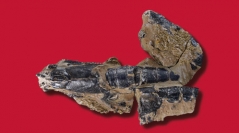

 Geodiversitas
45 (19) - Pages 573-588
Geodiversitas
45 (19) - Pages 573-588The Late Jurassic (late Oxfordian) fauna from Cricqueboeuf (Normandy, France) is remarkable for its three-dimensionally fossilized crustaceans in carbonate and phosphate nodules, some even preserving eyes and ommatidia network. The crustacean fauna includes four species assigned to the Mecochiridae (Meyeria hurtrelleorum n. sp.), Glypheidae (Glypheopsis trouvillensis), and Erymidae (Eryma ventrosum, Enoploclytia sp.). A quantitative analysis based on 191 specimens shows that the fauna was dominated by Eryma ventrosum (46.6% of specimens) and Meyeria hurtrelleorum n. sp., (40.3%), which makes it unique in the fossil record of the Jurassic crustacean assemblages. Meyeria hurtrelleorum n. sp. is one of the oldest occurrences of the genus and its abundance at Cricqueboeuf is outstanding. The palaeoenvironment is interpreted as subtidal mud flats, where the soft substrate was favorable to the settlement and burrowing of both glypheid, mecochirid, and erymid lobsters. Most of the specimens may actually have been preserved directly inside their own burrow, ultimately infilled by reworking of the muddy bottom during detrital inputs.
Crustacea, Decapoda, Glypheoidea, Glypheidae, Mecochiridae, Erymoidea, Erymidae Jurassic, Normandy, France, new species